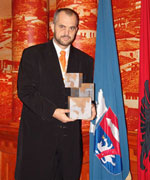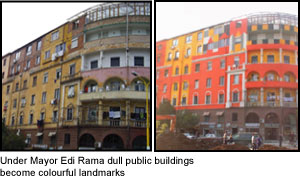
Edi Rama, former Mayor of Tirana, receives the 2004 World Mayor award

FRONT PAGE
Site Search
About us | Quiénes somos |
A propos de nous | Über uns |
Mayor Monitor
Directories
Events
Debate

World Mayor
World index of mayors
Mayors from Africa
Mayors from Asia & Australia
Mayors from The Americas
Mayors from Europe
Mayors and political parties
World's largest cities
and their mayors
Mayors of the Month
Mayor of Ljubljana
Mayors from Europe
(Former mayors in italics)
| Almada | Amaroussion | Amsterdam (Cohen) | Amsterdam (van der Laan) | Antwerp | Athens | Barcelona | Berlin | Bologna | Bonn | Bremen | Chania | Cologne | Córdoba | Doncaster | Elbasan | Evry | Ghent | Gothenburg | Hamburg | Hartlepool | Kraków | La Laguna | Lewisham | Lille | London (Johnson) | London (Livingstone) | Lyon | Malmö | Middlesbrough | Montreuil-sous-Bois | Moscow | Munich | Nicosia | Nuremburg | Paris | Reims | Rhodes | Riace | Rome (Alemanno) | Rome (Veltroni) | Rouen | Sofia | Stockholm | Stuttgart | Tirana | Tower Hamlets | Turin | Ulm | Vienna | Wroclaw | Zurich (Ledergerber) | Zurich (Mauch) |

City Mayors reports news from towns and cities around the world. Worldwide | Elections | North America | Latin America | Europe | Asia | Africa | Events |

Mayors from The Americas, Europe. Asia, Australia and Africa are competing for the annual World Mayor Award. More

City Mayors ranks the world’s largest as well as richest cities and urban areas. It also ranks the cities in individual countries, and provides a list of the capital cities of some 200 sovereign countries. More

City Mayors reports political events, analyses the issues and depicts the main players. More

City Mayors describes and explains the structures and workings of local government in Europe, The Americas, Asia, Australia and Africa. More

City Mayors profiles city leaders from around the world and questions them about their achievements, policies and aims. More

City Mayors deals with economic and investment issues affecting towns and cities. More

City Mayors reports on how business developments impact on cities and examines cooperation between cities and the private sector. More

City Mayors describes and explains financial issues affecting local government. More

City Mayors lists and features urban events, conferences and conventions aimed at urban decision makers and those with an interst in cities worldwide. More

City Mayors reports urban environmental developments and examines the challenges faced by cities worldwide. More

City Mayors reports on and discusses urban development issues in developed and developing countries. More

City Mayors reports on developments in urban society and behaviour and reviews relevant research. More

City Mayors deals with urban transport issues in developed and developing countries and features the world’s greatest metro systems. More

City Mayors examines education issues and policies affecting children and adults in urban areas. More

City Mayors investigates health issues affecting urban areas with an emphasis on health in cities in developing countries. More

City Mayors examines the importance of urban tourism to city economies. More

City Mayors examines the contributions history and culture make to urban society and environment. More

City Mayors describes the history, architecture and politics of the greatest city halls in the world. More

City Mayors invites readers to write short stories about people in cities around the world. More

City Mayors questions those who govern the world’s cities and talks to men and women who contribute to urban society and environment. More

City Mayors profiles national and international organisations representing cities as well as those dealing with urban issues. More

City Mayors reports on major national and international sporting events and their impact on cities. More

City Mayors lists cities and city organisations, profiles individual mayors and provides information on hundreds of urban events. More
Edi Rama: Artist, reformer
and former Mayor of Tirana
By Nick Swift
17 March 2004: Edi Rama’s journey to the mayor’s office in Tirana, the capital of Albania, arguably began in what most would call a raw and rough-and-tumble way inasmuch as, even though he, while still teaching at the Albanian Academy of Arts – admittedly a site of political ferment after the termination of communism and the birth of the Democratic Party in 1990 – had quickly left what he considered a bogus movement, and was doing no more than criticize both the socialists and the democrats in print, someone showed how seriously they took that by lying in wait for him in front of his home and beating him nearly to death. Mr. Rama is in no doubt that his attackers that night in 1997 were sent by then-president Sali Berisha.
On 18 February 2007 Edi Rama was re-elected for a third term as Mayor of Tirana.
How good is Mayor Rama?
 When he had finally regained his health, Edi Rama resumed his career as a painter and sculptor in Paris, but returned to Albania in 1998 when his father died, and after a new government under Fatos Nano had assumed power. The country then was the product of half a century of Stalinist dictatorship topped off with ten years of free market indiscipline, and layered with organized crime. The capital itself was mired in the waste of under-served overpopulation, with corruption in the civil service having facilitated the emergence of a chaos of illegal buildings and decaying streets.
When he had finally regained his health, Edi Rama resumed his career as a painter and sculptor in Paris, but returned to Albania in 1998 when his father died, and after a new government under Fatos Nano had assumed power. The country then was the product of half a century of Stalinist dictatorship topped off with ten years of free market indiscipline, and layered with organized crime. The capital itself was mired in the waste of under-served overpopulation, with corruption in the civil service having facilitated the emergence of a chaos of illegal buildings and decaying streets.
On the evening of the day in the morning of which Mr. Rama attended the service for his father, the phone rang, and it was Prime Minister Nano, who addressed him as ‘Mr. Minister of Culture’. Mr. Rama heard the call of duty, and answered, he says, without thinking. He soon found the straight-laced aspect of his role disagreeable, and it turned out that becoming (after getting permission) tieless was only the beginning; the restoration of blood flow to the future mayor’s head gave him the idea of opening movie theatres in Tirana, and showing popular foreign films in them, an entirely new phenomenon for Albania.
In October 2000, Mr. Rama ran as an Independent with Socialist Party support for the job of Mayor of Tirana, and won with a 54 per cent majority.
Within a month there was another attempt on his life when shots were fired into his flat.
Any idea of the artist as as impractical dreamer is shattered by Edi Rama’s achievements so far. He claims still to be an artist first and most of all, and activities in public service are an extension of his aesthetic sensibility into the realm of action and life. He shrewdly appraises the legacy of communism as a cultural and social toxin that cannot be eliminated except over time, and perhaps a very long time. But he is helping restore Tirana society’s immune system and positive attitude by, for example, the Return to Identity Programme, ruthlessly razing the haphazard and, often, environmentally seriously damaging outlaw buildings of all kinds in order to produce a clean slate on which urban planning can occur that will meet the needs of present and future generations.
He allied himself with the United Nations Development Programme in 2001, and launched the Clean and Green project in Tirana to deal with the consequences of the pollution of the Lana River, generating new green spaces and thousands of new trees. He has reduced unemployment, partly by putting Tiranans to work on such projects. Two years after becoming mayor, Edi Rama went to New York to collect the Poverty Eradication Award from United Nations Secretary General Kofi Annan. “I see this,” he told Voice of America TV in Albanian, “as an important event for the capital rather than my personal life... This award represents recognition for a coordinated effort among many individuals and a synergy of energies and financial resources.”
The depth and breadth of Mayor Rama’s vision and accomplishments to date belie the criticism that he is over-preoccupied with merely cosmetic changes, and that he illegitimately extends the legitimacy of his fondness for colourful shirts to a penchant for painting dull public buildings in the ‘Edi Rama colours’ of green, violet and yellow. The concise version of his reply to that charge is that it is, in essence, all to make the best possible impression on the sort of people Tirana and Albania have the most to gain by impressing favourably: foreign VIPs.
It is not as if he is unaware that the gaiety of those appearances is counterbalanced by the severe poverty that is the more apparent the farther one travels from the city centre.
Focusing the correctness of his politics on forms of integrity that matter to his constituents means that the tendency of his staff to be female and pulchritudinous should be, as far as he is concerned, of no signficance in view of the fact that they do their jobs well.
The Democratic Party of Albania in 2003 attempted to have a parliamentary commission established to investigate use of public funds by the municipality of Tirana, evidently with the intention of undermining Mr. Rama’s chances of being re-elected later in the year. They lost inasmuch as the commission, as a condition stipulated by the Socialist Party, will investigate as far back as 1992, when the Democrats themselves were in power: and, in 2004, Edi Rama is still Mayor of Tirana, with, this time, just under 59 per cent of the vote.
In 2006, Edi Rama was elected leader of the Socialist Party, Albania's largest opposition party. He is likely to be the party's candidate for prime minister in the next general election.

